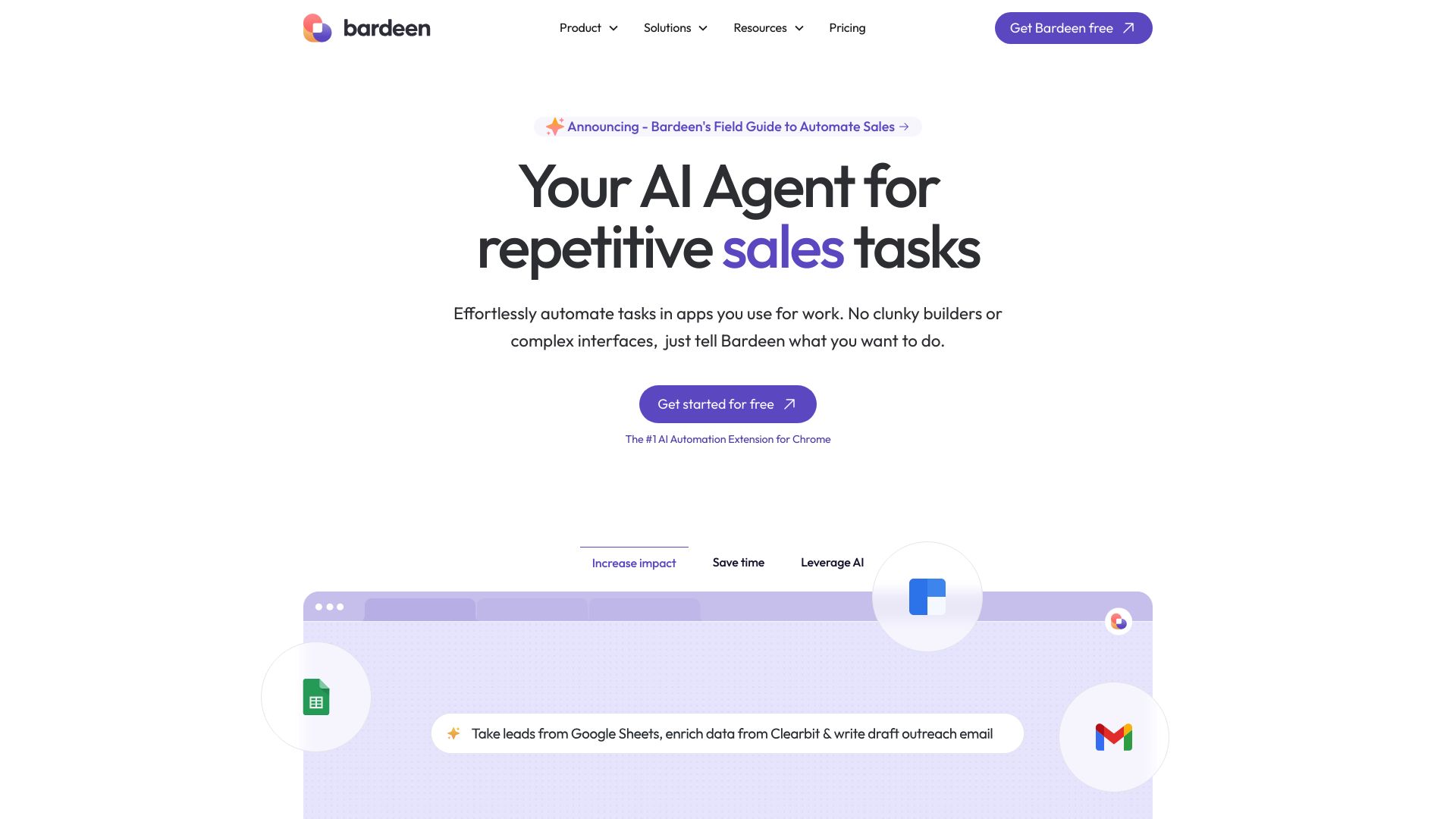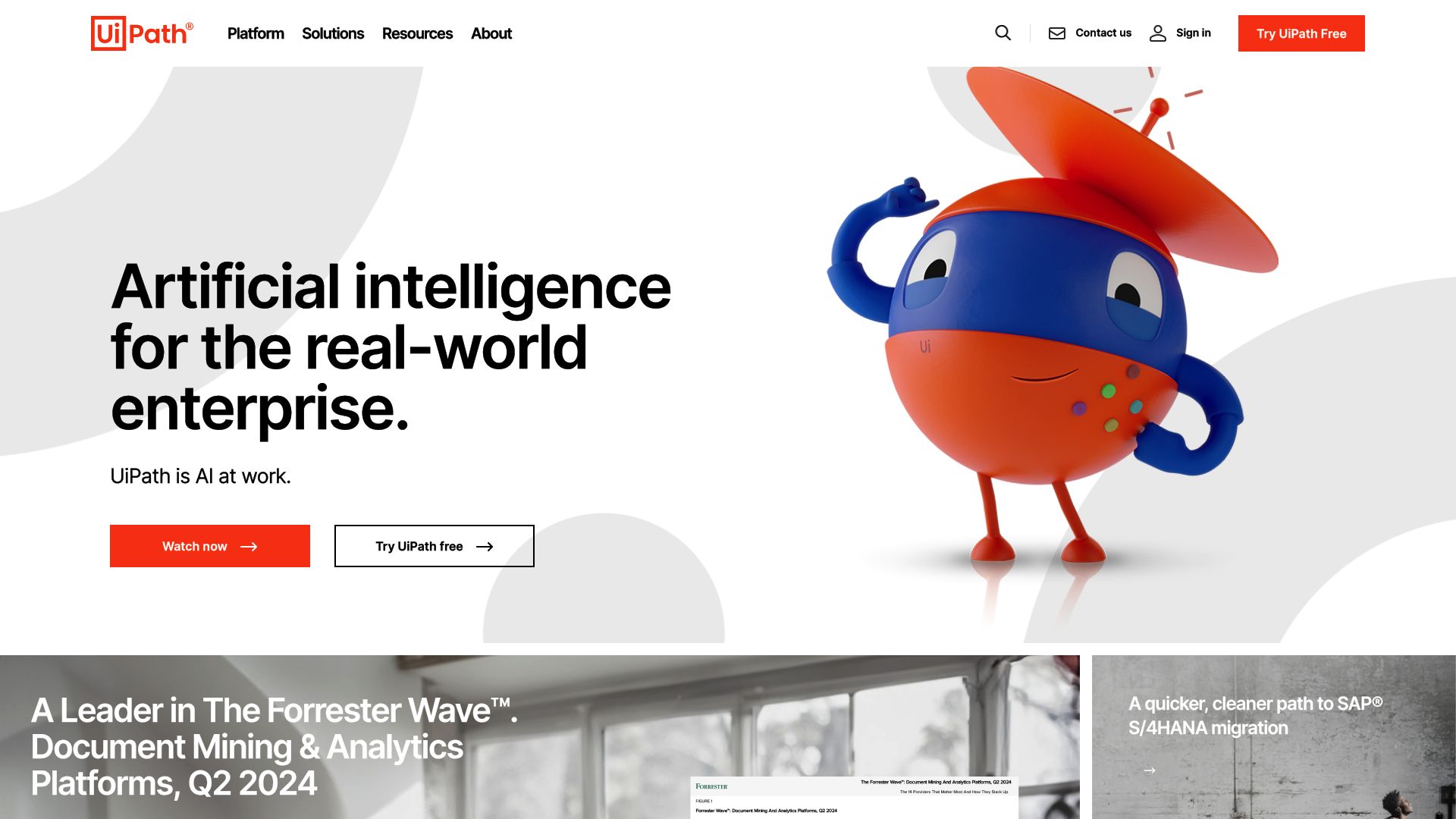Bardeen AI vs. UiPath: Comparing AI Automation Platforms
Artificial Intelligence revolutionizes software automation, empowering businesses to streamline operations and boost productivity. Our comparison of Bardeen AI vs. UiPath, and SmythOS unveils the strengths and limitations of each platform. We explore their unique approaches to automation, from Bardeen AI’s browser-based simplicity to UiPath’s enterprise-grade solutions.
Discover how SmythOS combines user-friendly interfaces with advanced AI capabilities, offering a versatile solution for businesses of all sizes. Whether you’re a developer seeking powerful APIs, a business leader focused on scalability, or a non-technical user looking for accessible tools, this review provides the insights you need to choose the right AI automation platform for your needs.
Bardeen AI Overview
Bardeen AI offers a no-code web automation platform delivered as a Chrome browser extension. The platform empowers users to automate repetitive web-based tasks through pre-built templates and a visual workflow builder, without requiring coding expertise.


Bardeen’s key features include a drag-and-drop workflow builder for creating automations called Playbooks, a library of pre-built actions and triggers for popular apps like Gmail and LinkedIn, and AI-powered capabilities such as text classification and data extraction. The platform leverages models like GPT-3 to enhance its automation capabilities.
Unlike traditional automation tools, Bardeen emphasizes human-in-the-loop interaction. Users can actively engage with automations, validating data, guiding processes, and providing inputs as needed. This approach allows for more personalized and context-aware automations, tailored to specific user needs rather than offering a one-size-fits-all solution.
While Bardeen excels in UI-based web automation and offers strengths in visual builders, limited collaboration features, and integrations with popular apps, it lacks capabilities in areas such as independent agents, extensive scalability, and deployment options beyond browser extensions. The platform’s focus on browser-based Robotic Process Automation (RPA) with human oversight makes it well-suited for use cases where some ongoing user participation is feasible, rather than completely hands-off automation scenarios.
Bardeen’s vision centers on democratizing automation by enabling users to build workflows for their repetitive tasks without coding expertise. The platform aims to evolve automation from pure efficiency gains to augmenting human capabilities through AI participation. However, gaps remain in more complex orchestration or hosting for enterprise-wide needs, limiting its applicability in certain advanced use cases.
Bardeen’s vision centers on democratizing automation by enabling users to build workflows… without coding expertise. The platform aims to evolve automation…
UiPath Overview
UiPath revolutionizes enterprise automation with its comprehensive end-to-end platform. The software empowers organizations to discover, build, manage, run, and measure automation across departments, streamlining operations and boosting productivity. UiPath’s robust suite of tools covers the entire automation lifecycle, from process mining to development, deployment, monitoring, and analytics.
The platform excels in enterprise-scale automation, catering to large organizations with complex systems and stringent governance requirements. UiPath’s seamless integration capabilities allow businesses to connect workflows across disparate systems effortlessly. The software’s robot orchestration feature enables centralized management of a scalable robotic workforce, capable of executing automations 24/7.
UiPath distinguishes itself by supporting both attended and unattended automation. This versatility allows for the automation of front-office tasks requiring human input as well as back-office processes that can run autonomously. The platform’s focus on structured workflow automation sets it apart from general conversational AI or problem-solving tools, making it ideal for businesses seeking to optimize repetitive tasks and processes.


While UiPath offers powerful automation capabilities, it may present a steeper learning curve for users without technical backgrounds. The platform’s enterprise focus might also make it less suitable for small businesses or individual developers looking for simpler automation solutions. Additionally, the cost structure of UiPath can be prohibitive for smaller organizations or those with limited budgets.
UiPath’s enterprise focus might also make it less suitable for small businesses or individual developers looking for simpler automation solutions.
Despite these considerations, UiPath’s commitment to innovation and its robust feature set make it a formidable player in the enterprise automation market. The platform’s ability to scale, integrate with existing systems, and provide comprehensive analytics positions it as a valuable tool for organizations looking to drive digital transformation and operational efficiency.
Feature Comparison
Bardeen AI and UiPath offer distinct approaches to automation, with notable differences in their core components and security features. Bardeen AI provides a browser-based, no-code platform focused on web automation through a Chrome extension. Its visual workflow builder empowers users to create custom automations called Playbooks without coding expertise. Bardeen AI leverages AI models like GPT-3 for enhanced capabilities but lacks hosted agent environments and advanced deployment options.
UiPath, on the other hand, delivers a comprehensive enterprise-grade automation platform. It excels in scalability, offering robust tools for process mining, development, deployment, and analytics across large organizations. UiPath supports both attended and unattended automation, enabling front-office and back-office process optimization. Unlike Bardeen AI, UiPath provides extensive security features, including data encryption and fine-grained access controls, making it better suited for enterprises with stringent compliance requirements.
While both platforms aim to democratize automation, they target different user segments. Bardeen AI’s browser-centric approach limits its deployment options compared to UiPath’s versatile enterprise integration capabilities. UiPath’s focus on structured workflow automation and scalable robotic workforce management contrasts with Bardeen AI’s emphasis on personalized, human-in-the-loop automations for individual users and small teams.
| Bardeen AI | UiPath | SmythOS | |
|---|---|---|---|
| CORE FEATURES | |||
| AI Agents | ✅ | ❌ | ✅ |
| Hosted Agents (Dev, Production) | ✅ | ❌ | ✅ |
| No-Code Options | ✅ | ❌ | ✅ |
| Memory & Context | ❌ | ❌ | ✅ |
| Autonomous Agents | ❌ | ❌ | ✅ |
| Explainability & Transparency | ✅ | ❌ | ✅ |
| Debug Tools | ❌ | ✅ | ✅ |
| Multimodal | ❌ | ❌ | ✅ |
| Problem-Solving Capabilities | ❌ | ❌ | ✅ |
| Multi-Agent Collaboration | ❌ | ❌ | ✅ |
| Audit Logs for Analytics | ❌ | ✅ | ✅ |
| Work as Team | ✅ | ❌ | ✅ |
| SECURITY | |||
| Constrained Alignment | ❌ | ❌ | ✅ |
| IP Control | ❌ | ✅ | ✅ |
| COMPONENTS | |||
| Foundation AIs | ❌ | ❌ | ✅ |
| Huggingface AIs | ❌ | ❌ | ✅ |
| Zapier APIs | ❌ | ❌ | ✅ |
| Classifiers | ✅ | ❌ | ✅ |
| Logic | ❌ | ✅ | ✅ |
| Data Lakes | ❌ | ❌ | ✅ |
| DEPLOYMENT OPTIONS (EMBODIMENTS) | |||
| Deploy as API | ❌ | ❌ | ✅ |
| Deploy as Webhook | ❌ | ❌ | ✅ |
| Staging Domains | ❌ | ❌ | ✅ |
| Production Domains | ❌ | ❌ | ✅ |
| API Authentication (OAuth + Key) | ❌ | ✅ | ✅ |
| Deploy as Site Chat | ❌ | ❌ | ✅ |
| Deploy as Scheduled Agent | ✅ | ❌ | ✅ |
| Deploy as GPT | ❌ | ❌ | ✅ |
| DATA LAKE SUPPORT | |||
| Hosted Vector Database | ❌ | ❌ | ✅ |
| Sitemap Crawler | ❌ | ❌ | ✅ |
| YouTube Transcript Crawler | ✅ | ❌ | ✅ |
| URL Crawler | ❌ | ❌ | ✅ |
| Word File Support | ❌ | ✅ | ✅ |
| TXT File Support | ❌ | ❌ | ✅ |
Best Alternative to Bardeen AI and UiPath
SmythOS emerges as the superior alternative to Bardeen AI and UiPath, offering a comprehensive AI automation platform that combines powerful features with unparalleled ease of use. Our solution stands out by providing a versatile environment for creating and deploying AI agents across a wide range of applications.
Unlike Bardeen AI’s browser-centric approach or UiPath’s focus on enterprise-grade RPA, SmythOS delivers a flexible system that caters to both individual users and large organizations. We offer a visual builder and no-code options that democratize AI development, allowing users of all skill levels to create sophisticated automations. This accessibility doesn’t come at the cost of advanced capabilities — our platform supports complex, multi-agent collaborations and problem-solving that goes beyond simple task automation.
SmythOS delivers a flexible system that caters to both individual users and large organizations… allowing users of all skill levels to create sophisticated automations.
SmythOS excels in areas where Bardeen AI and UiPath fall short. While Bardeen AI lacks robust deployment options and UiPath focuses primarily on structured workflows, we provide a full spectrum of deployment choices. Users can deploy their agents as APIs, webhooks, scheduled tasks, or even integrate them into chat interfaces. This versatility ensures that SmythOS can adapt to virtually any use case or business need.
Security and scalability set SmythOS apart from the competition. We implement advanced features like constrained alignment and comprehensive data encryption, addressing the stringent security requirements of enterprise users. Unlike Bardeen AI’s limited scalability or UiPath’s complex enterprise focus, SmythOS offers a seamless scaling experience that grows with your needs, from individual projects to organization-wide deployments.
SmythOS offers a seamless scaling experience that grows with your needs, from individual projects to organization-wide deployments.
By choosing SmythOS, users gain access to a future-proof platform that continually evolves to meet emerging challenges in AI automation. Our commitment to innovation, coupled with an intuitive user experience, positions SmythOS as the ideal choice for those seeking to harness the full potential of AI agents in their workflows.
Conclusion
Bardeen AI and UiPath each offer unique approaches to automation, catering to different user needs and organizational scales. Bardeen AI excels in providing a user-friendly, browser-based automation platform for individuals and small teams, emphasizing personalized workflows and human-in-the-loop interactions. UiPath, on the other hand, delivers a robust, enterprise-grade automation solution, focusing on scalability, comprehensive process management, and extensive integration capabilities for large organizations.
While both platforms have their strengths, SmythOS emerges as the superior choice, combining the best of both worlds and offering additional critical features. SmythOS provides an intuitive drag-and-drop interface similar to Bardeen AI, making it accessible to non-technical users. However, it surpasses Bardeen AI’s capabilities by offering advanced features like multi-agent collaboration, autonomous agents, and a wide range of deployment options. Unlike UiPath’s steep learning curve and enterprise focus, SmythOS caters to businesses of all sizes, offering scalability without compromising on user-friendliness.
SmythOS stands out with its comprehensive AI integration, supporting various AI models and offering features like multimodal interactions, problem-solving capabilities, and explainable AI. These advanced features, combined with robust security measures and versatile deployment options, position SmythOS as the ideal choice for businesses looking to leverage AI-powered automation effectively. To experience the power and flexibility of SmythOS firsthand, create a free SmythOS account and start building your AI-powered workflows today.
Last updated:
Disclaimer: The information presented in this article is for general informational purposes only and is provided as is. While we strive to keep the content up-to-date and accurate, we make no representations or warranties of any kind, express or implied, about the completeness, accuracy, reliability, suitability, or availability of the information contained in this article.
Any reliance you place on such information is strictly at your own risk. We reserve the right to make additions, deletions, or modifications to the contents of this article at any time without prior notice.
In no event will we be liable for any loss or damage including without limitation, indirect or consequential loss or damage, or any loss or damage whatsoever arising from loss of data, profits, or any other loss not specified herein arising out of, or in connection with, the use of this article.
Despite our best efforts, this article may contain oversights, errors, or omissions. If you notice any inaccuracies or have concerns about the content, please report them through our content feedback form. Your input helps us maintain the quality and reliability of our information.
